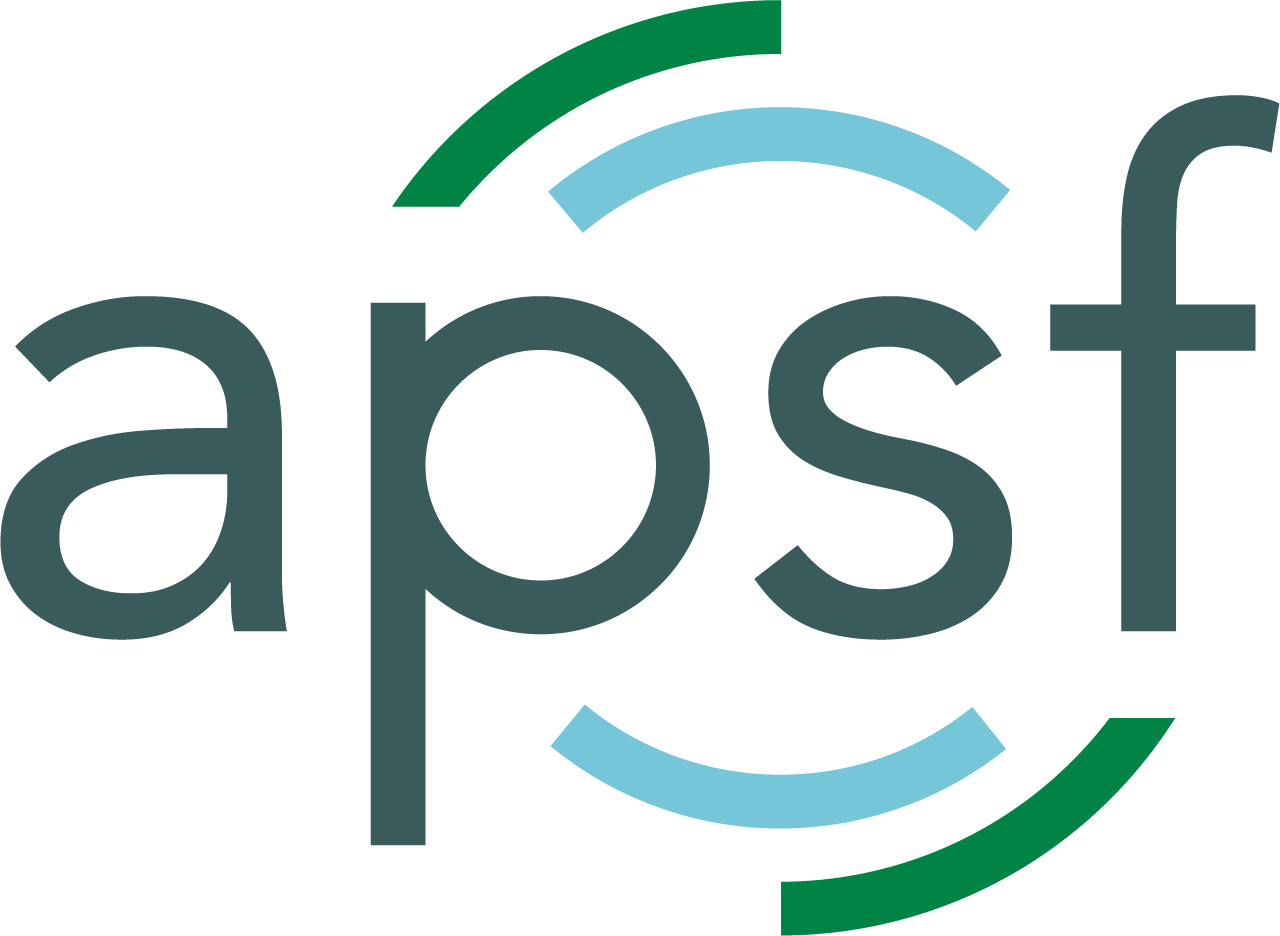As President of the Anesthesia Patient Safety Foundation (APSF), it is my privilege to report annually on the activities of the foundation during the past calendar year. I am pleased that 2008 has been an active and rewarding year as the APSF pursues safety initiatives intended to further our vision that “no patient shall be harmed by anesthesia.”
The APSF was able to continue in 2008 its increased funding of patient safety research that was initiated in 2007. This critically important expansion of research support is made possible, in part, by the full support ($150,000 each) of named research awards (Cardinal Health Foundation, Anesthesia Healthcare Partners, Eisai, Inc., American Society of Anesthesiologists [ASA]), and the partial support of one named grant at the $100,000 level by Covidien.
Research
The APSF Committee on Scientific Evaluation chaired by Sorin J. Brull, MD, received 32 grant applications in 2008 for awards to begin in January 2009. In October 2008, the committee recommended funding 6 research awards, for a total of $783,793. Among the named grants, was the first APSF/ASA President’s Endowed Research Award. This award plus the APSF/ASA Endowed Research Award utilizes funds from the APSF endowment fund, which was made possible by contributions from ASA to the APSF over the past 20 years.
The awarding of nearly $800,000 for anesthesia patient safety research by the APSF in October 2008 makes the APSF the largest private funding source for anesthesia patient safety research in the world. I take extreme pride along with my colleagues in endorsing this level of patient safety research support from the APSF. Since the inception of the APSF grant program, more than 400 grant applications have been reviewed by the APSF. When the first grants were funded in 1987, funding for anesthesia patient safety research was virtually nonexistent. Since 1987, the APSF has awarded 83 grants for a total of more than $5.3 million. The impact of these research grants is more far-reaching than the absolute number of grants and total dollars, as APSF-sponsored research has led to other investigations and the development of a cadre of anesthesia patient safety investigators.
APSF Newsletter
The APSF Newsletter continues its role as a vehicle for rapid dissemination of anesthesia patient safety information with Robert C. Morell, MD, as its editor. Lorri A. Lee, MD, has assumed the role of associate editor. The circulation of the APSF Newsletter exceeds 83,000 recipients including members of the ASA, American Association of Nurse Anesthetists (AANA), American Academy of Anesthesiologist Assistants (AAAA), and the American Society of Anesthesia Technologists and Technicians (ASATT).
Important issues presented in recent editions of the APSF Newsletter include the report of the October 2007 APSF Workshop on “Formal Training and Assessment before Using Advances Medical Devices in the Operating Room.” This report was written by MIchael A. Olympio, MD, chair, APSF Committee on Technology, and concludes with this recommendation: “The APSF believes the logic is compelling to require confirmation of competency before using unfamiliar and/or complex anesthesia equipment that can directly affect patient safety.”
The Spring 2008 APSF Newsletter carried the front page headline, “If my spine surgery went fine, why can’t I see?” followed by an article written by an anesthesiologist (now retired) who experienced perioperative visual loss after major spine surgery. This article was followed by an update on perioperative visual loss, a comprehensive review of informed consent, and a spine surgeon’s perspective. It is the hope of the APSF that these articles will increase awareness of perioperative visual loss, encourage appropriate informed consent, and stimulate research that may reduce or eliminate this perioperative complication.
Other topics presented in recent issues of the APSF Newsletter included “New Guidelines Available for Pre-Anesthesia Checkout,” written by Drs. Feldman, Olympio, Martin, and Striker; “Medication Administration in Anesthesia: Time for a Paradigm Shift,” written by Drs. Stabile, Webster, and Merry; and “Beach Chair Position may Decrease Cerebral Perfusion: Catastrophic Outcomes Have Occurred,” written by Drs. Cullen and Kirby. The article by Cullen and Kirby resulted in a letter to the editor from James Munis, MD, discussing the physiology of blood pressure levels during anesthesia and the misconceptions associated with blood pressure and cerebral perfusion.
The Questions and Answers and Dear SIRS (Safety Information Response System) columns in the APSF Newsletter provide rapid dissemination of safety issues related to anesthesia equipment in response to questions from readers. These columns are coordinated by Drs. Olympio and Morell. A section in the APSF Newsletter entitled Innovative Technology and Pharmaceuticals is intended to describe innovative technological or pharmaceutical developments that may impact patient safety. It is inevitable that this column may discuss products that are sold or distributed by entities that have or continue to support the APSF financially. The APSF will strive to disclose those relationships as appropriate.
Electronic Newsletter
The APSF is exploring various options in reducing costs including the possibility of converting the APSF Newsletter to an electronic format. Currently it costs about $1.25 per copy to produce, print, and mail the quarterly issues of the APSF Newsletter to some 83,000 recipients. Over the year, the APSF has conducted surveys (APSF website, ASA website, AANA annual meeting, ASA annual meeting) asking readers their reaction to elimination of the hardcopy in favor of an eNewsletter. The results of these surveys suggest that up to 60% of readers would find an eNewsletter acceptable. Currently, all issues of the APSF Newsletter are available on the APSF website (www.apsf.org). One option may be to provide the quarterly issues of the Newsletter in an electronic format to all current recipients and offer a subscription to those who wish to also receive a hard copy. Your comments on an electronic newsletter would be most welcome ([email protected]).
Communication
The APSF website is coordinated by George A. Schapiro, APSF executive vice president for development. The APSF website includes a monthly poll question related to anesthesia patient safety issues. This poll question is coordinated by Richard C. Prielipp, MD, chair, APSF Committee on Education and Training.
Sorin J. Brull, MD, chair of the APSF Committee on Scientific Evaluation, continues as the Patient Safety Section editor for Anesthesia & Analgesia.
The APSF sponsored a panel at the 2008 Annual Congress of the International Anesthesia Research Society (IARS) on perioperative anticoagulant management of patients with cardiac stents. This panel was organized and moderated by Richard C. Prielipp, MD. A panel on fire safety moderated by Dr. Prielipp is planned for the 2009 IARS meeting.
The APSF was an “endorsing organization” for the World Health Organization Safe Surgery Saves Lives launch event held in Washington, DC, on June 25, 2008. John H. Eichhorn, MD, consultant to the APSF Executive Committee, represented the APSF at this event.
Strategic Planning and Development
The APSF continues to fund and support “patient safety initiatives” with immediate and future implications for anesthesia professionals. In this regard, the APSF has contracted with the ECRI Institute to produce an interactive multimedia fire safety video that parallels the ASA Practice Advisory for the Prevention and Management of Operating Room Fires. The APSF will pay the entire cost of this creating this educational product.
The APSF has agreed to provide a grant of $60,000 to the Society for Pediatric Anesthesia (SPA) to partially support the start-up costs of establishing a registry (Pediatric Anesthesia Quality Improvement Project: Wake Up Safe) for adverse perioperative pediatric events. This grant combined with SPA support of $50,000 and $15,000 over 2 years from each of 10 participating hospitals will create the infrastructure for this registry. The APSF will provide an ex officio representative on the SPA Committee responsible for leading this project.
The APSF has endorsed a web-based survey on the use of muscle relaxants, neurophysiological monitoring, and reversal of drug effects.
The Data Dictionary Task Force (DDTF)/ International Organization for Terminology in Anesthesia (IOTA), chaired by Terri G. Monk, MD, continues to progress toward its goal of a common terminology of anesthesia terms that will allow the merging of data from disparate automated information systems. Ultimately it is hoped that data from automated information systems will lead to a better understanding of best practices and improved patient safety. To date the activities of the DDTF/IOTA have been entirely supported by the APSF and the vendors of information technology (see the APSF website for list of vendor supporters).
The APSF will sponsor a safety curriculum panel and a technology safety education panel at the 2009 annual meeting of the Society for Education in Anesthesia. These 2 panels will be funded by the APSF and organized by members of the APSF Board of Directors (Drs. Michael A. Olympio and Matthew B. Weinger).
Medication Safety
The topic for the 2008 APSF Board of Directors’ Workshop on Friday, October 17, 2008, was “Innovations in Medication Safety in the Operating Room.” The workshop was organized and moderated by Jeffrey B. Cooper, PhD, APSF executive vice president. The goals of the workshop were to identify 1) current possible solutions for medication errors in the operating room and 2) ideas for potential new processes to be developed and explored. The report for this workshop appears in this issue of the Newsletter.
Financial Support
Financial support to the APSF from individuals, specialty and component societies, and corporate partners in 2008 has been most gratifying. This sustained level of financial support makes possible the undertaking of new safety initiatives, the continuation of existing safety initiatives, and increased research funding. In 2008, the APSF awarded nearly $800,000 in research dollars to patient safety investigators. This amount plus the production of the fire safety video and the grant to the Society for Pediatric Anesthesia reflects an investment of nearly $1 million in patient safety research and initiatives.
Contributions to the APSF from all sources in 2009 represent an unknown quantity based on the recent events in the economy. The APSF can only monitor the effects of these changes and adjust its budget (principally anesthesia patient safety research awards) based on income.
Online Donations
The APSF website has been updated to accept “online” credit card contributions to the APSF. Go to “make a donation” on the APSF home page and follow the prompts.
APSF as a Unique and Separate Foundation
Occasionally there are those who advocate the merging of all ASA foundations either administratively or as a single entity. As President of the APSF, I believe this would not be in the best interest of the APSF and the value it brings to patients and anesthesia professionals. My reasons for this position are described in the November 2008 ASA Newsletter in an article entitled, APSF: A Unique and Distinct ASA Foundation (http://www.asahq.org/Newsletters/nlarchives.htm).
Concluding Thoughts
The year 2008 was saddened by the loss of Ann S. Lofsky, MD, who served as a consultant to the Executive Committee. Dr. Lofsky was a frequent contributor of patient safety articles to the APSF Newsletter. Her contributions to anesthesia patient safety will serve as a lasting memory to her special place in the efforts of the APSF to achieve its vision that “no patient shall be harmed by anesthesia.”
APSF is pleased to welcome Mark A. Warner, MD, and Steven Sanford, JD, as members-at-large to the APSF Executive Committee. Patricia A. Kapur, MD, has joined the APSF Executive Committee as a consultant.
As in the previous annual report, I wish to reiterate the desire of the APSF Executive Committee to provide a broad-based consensus on anesthesia patient safety issues. We welcome comments and suggestions from all those who participate in the common goal of making anesthesia a safe experience. There remains much still to accomplish, and everyone’s participation and contributions are important.
Best wishes for a prosperous and rewarding year 2009.
Robert K. Stoelting, MD
APSF President


 Issue PDF
Issue PDF